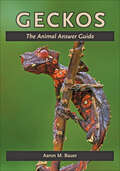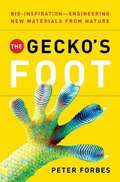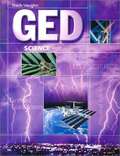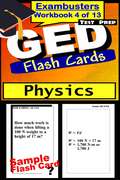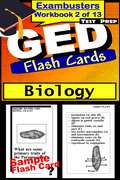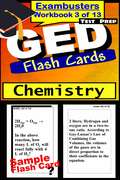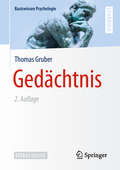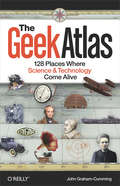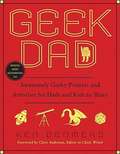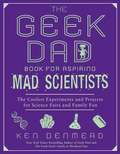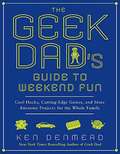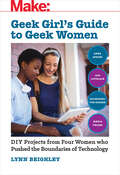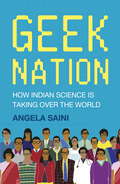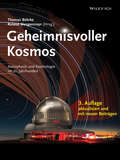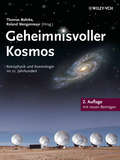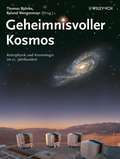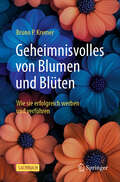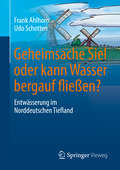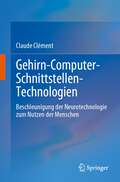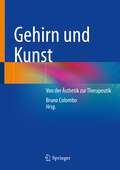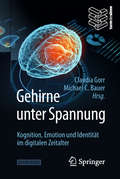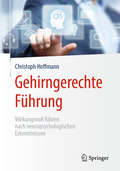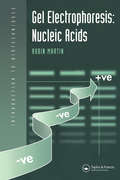- Table View
- List View
Geckos: The Animal Answer Guide (The Animal Answer Guides: Q&A for the Curious Naturalist)
by Aaron M. BauerEverything a student, naturalist, or curious observer wants to know about the biology and diversity of geckos.Q: How do geckos walk across ceilings? A: Millions of hair-like setae on each foot.Q: Where do geckos come from? A: Throughout the world. Usually where it’s warm.Q: How many species of geckos are there? A: Close to 1,500 and counting!Q: What do they eat? A: Insects mostly. Discover the biology, natural history, and diversity of geckos—the acrobatic little lizards made famous by a car insurance ad campaign. Lizard biologist and gecko expert Aaron Bauer answers deceptively simple questions with surprising and little-known facts. Readers can explore color photographs that reveal the natural wonder and beauty of the gecko form and are further informed by images of how geckos live in their natural habitats. Although written for nonexperts, Geckos also provides a carefully selected bibliography and a new list of all known species that will be of interest to herpetologists. Anyone who owns a gecko, has seen them in the wild, or has wondered about them will appreciate this gem of a book.
The Gecko's Foot: Bio-inspiration, Engineering New Materials from Nature
by Peter ForbesArising from a series of articles he wrote for The Guardian aimed at a serious-minded general audience, this book explores topics of materials science and nanotechnology, and new understandings of nature. Forbes is inspired by the subject and he draws together a significant amount of technical and scientific information.
GED: Science
by Steck-VaughnYou are taking a very big step toward changing your life with your decision to take the GED test. By opening this book, you are taking your second important step: preparing for the test.
GED Test Prep Flash Cards: Physics (Exambusters GED Workbook #4 of 13)
by Ace Inc.<P><P><i>Advisory: Bookshare has learned that this book offers only partial accessibility. We have kept it in the collection because it is useful for some of our members. Benetech is actively working on projects to improve accessibility issues such as these.</i><P><P> 600 questions. Sample problems. Topics: Metric System, Motion and Forces, Work and Energy, Fluids, Sound, Light and Optics, Static Electricity, D.C. and A.C. Circuits, Magnetism <P><P> "EXAMBUSTERS GED Prep Workbooks" provide comprehensive, fundamental GED review--one fact at a time--to prepare students to take practice GED tests. Each GED study guide focuses on one specific subject area covered on the GED exam. From 300 to 600 questions and answers, each volume in the GED series is a quick and easy, focused read. Reviewing GED flash cards is the first step toward more confident GED preparation and ultimately, higher GED exam scores!
GED Test Prep Flash Cards: Biology (Exambusters GED Workbook #2 of 13)
by Ace Inc.<P><P><i>Advisory: Bookshare has learned that this book offers only partial accessibility. We have kept it in the collection because it is useful for some of our members. Benetech is actively working on projects to improve accessibility issues such as these.</i><P><P> 450 questions. Topics: Cells, Biochemistry and Energy, Evolution, Kingdoms: Monera, Fungi, Protista, Plants, Animals; Human: Locomotion, Circulation, Immunology, Respiration, Excretion, Digestion, Nervous System <P><P> "EXAMBUSTERS GED Prep Workbooks" provide comprehensive, fundamental GED review--one fact at a time--to prepare students to take practice GED tests. Each GED study guide focuses on one specific subject area covered on the GED exam. From 300 to 600 questions and answers, each volume in the GED series is a quick and easy, focused read. Reviewing GED flash cards is the first step toward more confident GED preparation and ultimately, higher GED exam scores!
GED Test Prep Flash Cards: Chemistry (Exambusters GED Workbook #3 of 13)
by Ace Inc.<P><P><i>Advisory: Bookshare has learned that this book offers only partial accessibility. We have kept it in the collection because it is useful for some of our members. Benetech is actively working on projects to improve accessibility issues such as these.</i><P><P> 700 questions. Essential chemistry formulas and concepts. Topics: Metric System, Matter, Atoms, Formulas, Moles, Reactions, Elements, Chemical Bonds, Phase Changes, Solutions, Reaction Rates, Acids and Bases, Oxidation and Reduction, Introduction to Organic <P><P> "EXAMBUSTERS GED Prep Workbooks" provide comprehensive, fundamental GED review--one fact at a time--to prepare students to take practice GED tests. Each GED study guide focuses on one specific subject area covered on the GED exam. From 300 to 600 questions and answers, each volume in the GED series is a quick and easy, focused read. Reviewing GED flash cards is the first step toward more confident GED preparation and ultimately, higher GED exam scores!
Gedächtnis
by Thomas GruberDas Buch liefert einen Überblick über den aktuellen Wissenstand zum Thema Gedächtnis. Es richtet sich vor allem an Studierende und Lehrende der Psychologie, der Kognitions- und Neurowissenschaften und an psychologieinteressierte Laien. Inhaltlich liegt der Schwerpunkt auf Gedächtnissystemen und -prozessen. Es werden zentrale experimentelle Techniken zur Untersuchung der Einspeicherung, der Aufrechterhaltung und des Abrufes von Gedächtniseinträgen vorgestellt. Weiterhin wird den Leserinnen und Lesern vermittelt, wie solche Gedächtniseinträge im Gehirn implementiert sind. Die Inhalte spiegeln dabei eine ausgewogene Mischung zwischen den "Klassikern“ der Gedächtnisforschung und modernen Erkenntnissen aus den Kognitiven Neurowissenschaften wider. Exkurse in alltagsrelevante Anwendungsbereiche runden den ganzheitlichen Eindruck ab.
The Geek Atlas: 128 Places Where Science and Technology Come Alive
by John Graham-CummingThe history of science is all around us, if you know where to look. With this unique traveler's guide, you'll learn about 128 destinations around the world where discoveries in science, mathematics, or technology occurred or is happening now. Travel to Munich to see the world's largest science museum, watch Foucault's pendulum swinging in Paris, ponder a descendant of Newton's apple tree at Trinity College, Cambridge, and more.Each site in The Geek Atlas focuses on discoveries or inventions, and includes information about the people and the science behind them. Full of interesting photos and illustrations, the book is organized geographically by country (by state within the U.S.), complete with latitudes and longitudes for GPS devices. Destinations include:Bletchley Park in the UK, where the Enigma code was brokenThe Alan Turing Memorial in Manchester, EnglandThe Horn Antenna in New Jersey, where the Big Bang theory was confirmedThe National Cryptologic Museum in Fort Meade, MarylandThe Trinity Test Site in New Mexico, where the first atomic bomb was explodedThe Joint Genome Institute in Walnut Creek, CaliforniaYou won't find tedious, third-rate museums, or a tacky plaque stuck to a wall stating that "Professor X slept here." Every site in this book has real scientific, mathematical, or technological interest -- places guaranteed to make every geek's heart pound a little faster. Plan a trip with The Geek Atlas and make your own discoveries along the way.
Geek Dad
by Ken DenmeadThe ultimate DIY project guide for techie dads raising kids in their own geeky image, in the spirit of The Dangerous Book for Boys Today's generation of dads grew up more tech-savvy than ever. Rather than joining the Little League team, many grew up playing computer games, Dungeons and Dragons, and watching Star Wars. Now with kids of their own, these digital-age dads are looking for fresh ways to share their love of science and technology, and help their kids develop a passion for learning and discovery. Enter supergeek, and father of two, Ken Denmead. An engineer and editor of the incredibly popular GeekDad blog on wired.com, Ken has created the ultimate, idea-packed guide guaranteed to help dads and kids alike enjoy the magic of playtime together and tap into the infinite possibility of their imagination. With illustrations throughout, this book offers projects for all ages to suit any timeframe or budget. With Denmead's expert guidance, you and your child can: *Fly a night-time kite ablaze with lights or launch a video camera with balloons *Construct the "Best Slip n' Slide Ever," a guaranteed thrill ride *Build a working lamp with LEGO bricks and CDs *Create a customized comic strip or your own board game *Transform any room into a spaceship *Make geeky crafts like cyborg jack-o'-lanterns or Ethernet cuff links Brimming with endlessly fun and futuristic tidbits on everything from gaming to gadgets, GeekDad helps every tech-savvy father unleash his inner kid-and bond with the next generation of brainiacs. Watch a Video
The Geek Dad Book for Aspiring Mad Scientists
by Ken DenmeadFans of the New York Times bestselling Geek Dad and The Geek Dad's Guide to Weekend Fun will flock to the 3.0 version, The Geek Dad Book for Aspiring Mad Scientists. As Ken Denmead explains, most kids lack an understanding of science and an awareness of how it influences our everyday lives. What kids today need is a fun way to learn scientific concepts. This book will help scientists-in-the- making discover how our world works with creative project ideas, including how to: Grow crystals to power your Stargate and set your room aglow Extract your own DNA and decode your genes Build a MacGyver radio from nothing but cast-off electrical and office supplies Chock-full of instructional illustrations throughout, The Geek Dad Book for Aspiring Mad Scientists puts the fun back in science.
The Geek Dad's Guide to Weekend Fun
by Ken DenmeadThe wildly popular DIY dad follows up his instant New York Times bestseller with a fresh batch of geeky weekend science projects for the whole family to enjoy. Ken Denmead struck a chord with parents and kids across America with his GeekDad blog on Wired.com, which receives more than one million page views per month. His debut book, Geek Dad, was on bestseller lists and in its seventh printing just two months after hitting store shelves. With The Geek Dad's Guide to Weekend Fun, he keeps the nerdtastic novelties coming, with projects that teach readers how to: *Build homemade robots from scratch *Write and direct simple stop-motion movies *Hack into mechanical toys to add cool electronic twists, and more United by the premise that to really understand science and how something works you must design and build it yourself or remake it better, Geek Parents everywhere will celebrate this latest installment of weekend workshop wonders. Watch a Video
Geek Girl's Guide to Geek Women
by Lynn BeighleyThis hands-on book takes a look at four brilliant women -- Ada Lovelace, Anna Atkins, Hildegard Von Bingen, and Maria Telkes -- and the world-changing innovations they created. Walk in their footsteps as you discover how these women became inventors, learn what inspired them, and then try your hand at recreating their most famous inventions -- computer programs, solar photography, codes and ciphers, and water purifiers.
Geek Nation: How Indian Science is Taking Over the World
by Angela SainiIndia: it's a nation of geeks, swots and nerds. Almost one in five of all medical and dental staff in the UK is of Indian origin, and one in six employed scientists with science or engineering doctorates in the US is Asian. By the turn of the millennium, there were even claims that a third of all engineers in Silicon Valley were of Indian origin, with Indians running 750 of its tech companies. At the dawn of this scientific revolution, Geek Nation is a journey to meet the inventors, engineers and young scientists helping to give birth to the world?s next scientific superpower ? a nation built not on conquest, oil or minerals, but on the scientific ingenuity of its people. Angela Saini explains how ancient science is giving way to new, and how the technology of the wealthy are passing on to the poor. Delving inside the psyche of India?s science-hungry citizens, she explores the reason why the government of the most religious country on earth has put its faith in science and technology.Through witty first-hand reportage and penetrative analysis, Geek Nation explains what this means for the rest of the world, and how a spiritual nation squares its soul with hard rationality. Full of curious, colourful characters and gripping stories, it describes India through its people ? a nation of geeks.curious, colourful characters and gripping stories, it describes India through its people ? a nation of geeks.
Geek Nation: How Indian Science is Taking Over the World
by Angela SainiIndia: it's a nation of geeks, swots and nerds. Almost one in five of all medical and dental staff in the UK is of Indian origin, and one in six employed scientists with science or engineering doctorates in the US is Asian. By the turn of the millennium, there were even claims that a third of all engineers in Silicon Valley were of Indian origin, with Indians running 750 of its tech companies. At the dawn of this scientific revolution, Geek Nation is a journey to meet the inventors, engineers and young scientists helping to give birth to the world’s next scientific superpower – a nation built not on conquest, oil or minerals, but on the scientific ingenuity of its people. Angela Saini explains how ancient science is giving way to new, and how the technology of the wealthy are passing on to the poor. Delving inside the psyche of India’s science-hungry citizens, she explores the reason why the government of the most religious country on earth has put its faith in science and technology.Through witty first-hand reportage and penetrative analysis, Geek Nation explains what this means for the rest of the world, and how a spiritual nation squares its soul with hard rationality. Full of curious, colourful characters and gripping stories, it describes India through its people – a nation of geeks.curious, colourful characters and gripping stories, it describes India through its people – a nation of geeks.
Geheimnisvoller Kosmos: Astrophysik und Kosmologie im 21. Jahrhundert
by Thomas Bührke Roland WengenmayrFür die dritte Auflage wurden alle Aufsätze aktualisiert und sieben neue Beiträge aufgenommen. So komplettiert ein Kapitel über spektroskopische Biomarker das nunmehr mit drei Beiträgen vertretene, hoch aktuelle Thema extrasolare Planeten. Zwei neue Artikel zur Antimaterie befassen sich mit den physikalischen Grundlagen, insbesondere der Materie-Antimaterie-Asymmetrie im Urknall, und dem Nachweis von Antiteilchen im Weltraum. Die Problematik der Dunklen Materie erhellt ein Kapitel über die derzeit laufenden Laborexperimente. Beobachtungen mit dem Weltraumteleskop Herschel haben neue Erkenntnisse zur Galaxienentwicklung gebracht. Und nicht zuletzt lassen neue, hoch empfindliche Untersuchungen von Apollo-Mondgestein die Entstehung des Erdtrabanten in einem anderen Licht erscheinen. Astrophysik und Kosmologie machen also auch im 21. Jahrhundert große Fortschritte. „Sowohl der Fachwissenschaftler als auch der Hobbyastronom, der direkt am rasanten Erkenntnisgewinn der modernen Astrophysik und Kosmologie teilhaben möchte, kommt mit diesem Buch auf seine Kosten.“ Sterne und Weltraum „… Wer sich einen schnellen, gleichwohl gründlichen Eindruck von Ergebnissen, Methoden und Problemen der Astronomie im 21. Jahrhundert verschaffen will, kommt an diesem Buch nicht vorbei.“ MaxPlanck Forschung
Geheimnisvoller Kosmos: Astrophysik und Kosmologie im 21. Jahrhundert
by Herausgegeben Von Thomas Bührke Roland WengenmayrFür die zweite Auflage wurden alle Aufsätze aktualisiert und sieben neue Beiträge aufgenommen. So komplettieren zwei Kapitel über Sternenstaub in Meteoriten und Kometen sowie über komplexe organische Moleküle in der interstellaren Materie das große Thema Stern- und Planetenentstehung. Ein Aufsatz über die bislang unentdeckten ersten Sterne im Universum führt nahe an den Urknall heran, und eine Fotoreihe des Weltraumteleskops Hubble über kollidierende Galaxien demonstriert, dass es im Weltall mitunter recht turbulent zugeht. Auch der Raumfahrt wurde mehr Platz gewidmet. Ein Beitrag beschreibt die zukünftige unbemannte Rückholmission von Marsgestein zur Erde. Ein Erlebnisbericht des deutschen Astronauten Ulrich Walter von seinem Flug mit dem Space Shuttle Columbia erinnert an das Ende einer großen Ära.
Geheimnisvoller Kosmos: Astrophysik und Kosmologie im 21. Jahrhundert
by Roland Wengenmayr Thomas Bührke Herausgegeben VonDid mighty rivers once flow on Mars? How do dark energy and dark matter influence the development of the universe? What are they made of? What is the role of black holes in the creation of galaxies? In this book expert astrophysicists and cosmologists attempt to answer these highly pertinent questions in an objective manner. They describe fascinating model worlds and confront readers with unanswered questions. 'Geheimnisvoller Kosmos' is a guidebook to the limits of our current knowledge. Numerous color images and clear illustrations aid understanding and make this an enjoyable read.
Geheimnisvolles von Blumen und Blüten: Wie sie erfolgreich werben und verführen
by Bruno P. KremerBlüten sind die ästhetischen Höhepunkte des Pflanzenlebens. Mit einer geradezu unglaublichen Vielfalt an Farben und Formen lassen sie sogar ganze Landschaften in einem bunten Meer versinken. Blüten sind immer pure Freude für die Sinne. Noch faszinierender werden sie, wenn man ihren vielen kleinen Geheimnissen in Struktur und Funktion nachspürt. Erfahren Sie in diesem Buch u.a. wo sich im Blütenbau Fibonacci-Zahlen und die Proportionen des Goldenen Schnittes verstecken welche Bauplantypen und Blütenstile man unterscheiden kann wie Blumen werben, locken und ihre tierischen Besucher verführen welche Blütensignale als hilfreiche Betriebsanleitung für Bienen, Hummeln oder Schmetterlinge wirken mit welchen Raffinessen sie ihren Pollen auf die eingetroffenen Blütengäste übertragen warum manche Blüten ihren Nektar offen anbieten, während andere umständlich danach suchen lassen wie manche Blüten ihre Besucher hintergehen und täuschen auf welche Weise die „Verhütungstechnik“ vieler Blüten funktioniert Dieses Buch bietet Ihnen mit animativen Texten und ungewöhnlichen Bildern eine informative moderne Naturgeschichte der Blüten.
Geheimsache Siel oder kann Wasser bergauf fließen?
by Frank Ahlhorn Udo SchottenThema des vorliegenden Buches ist der Umgang mit dem Wasser an der niedersächsischen Küste (hier: die Entwässerung der niedrig liegenden Landschaft), eine fundamentale Angelegenheit für die Menschen, die hier leben und arbeiten. Für ein junges Zielpublikum wird unterhaltsam erläutert, wohin das Wasser fließt und welche Anstrengungen unsere Vorfahren unternommen hatten, damit wir in dieser Landschaft (über)leben können. Darüber hinaus werden Veränderungen, die z. B. über den Klimawandel auf diese Landschaft einwirken, in die Entdeckungsreise der vier Protagonisten eingebunden.
Gehirn-Computer-Schnittstellen-Technologien: Beschleunigung der Neurotechnologie zum Nutzen der Menschen
by Claude ClémentDieses Buch befasst sich mit dem Bereich der Gehirn-Computer-Schnittstellen (BCI) und dem einzigartigen und besonderen Umfeld aktiver Implantate, die eine elektrische Schnittstelle zum Gehirn, zum Rückenmark, zu peripheren Nerven und zu Organen bilden. Im Mittelpunkt des Buches steht die Heilung und Rehabilitation von Patienten mit schweren neurologischen Beeinträchtigungen, von Lähmungen bis hin zu Bewegungsstörungen und Epilepsie, die oft eine invasive Lösung auf der Grundlage eines implantierten Geräts erfordern. Frühere Errungenschaften, aktuelle Arbeiten und Zukunftsperspektiven von BCI und anderen Interaktionen zwischen medizinischen Geräten und dem menschlichen Nervensystem werden aus pragmatischer Sicht ausführlich beschrieben. gibt einen Überblick über die Branche der aktiven implantierbaren medizinischen Geräte (AIMDs) und wie sie sich von kardialen zu neurologischen Anwendungen entwickelt Klare, leicht zu lesende Darstellung des Bereichs der Neurotechnologien zum Nutzen des Menschen Bietet leicht verständliche Erklärungen zu den technischen Grenzen, den physikalischen Eigenschaften von Implantaten im menschlichen Körper und realistischen langfristigen Perspektiven
Gehirn, Psyche und Gesellschaft: Schlaglichter aus den Wissenschaften vom Menschen
by Stephan SchleimDieses Buch enthält eine Zusammenstellung von Artikeln zu aktuellen Fragen der Wissenschaften vom Menschen. Es spannt einen Bogen von der Philosophie und Psychologie bis hin zur Biologie, Hirnforschung und Medizin. Der Autor forscht und lehrt nicht nur in diesen Gebieten, sondern schreibt darüber seit über 15 Jahren für ein breites Publikum. Eine Auswahl der 33 wichtigsten Beiträge aus seinem erfolgreichen Blog MENSCHEN-BILDER (Spektrum der Wissenschaft) sind hier in überarbeiteter Form neu zusammengestellt und mit Einführungen und Ausblicken versehen. In sechs Abschnitten behandelt er Grundfragen von Neurophilosophie und -Theologie, Neuroethik, psychischen Störungen, Lebensphilosophie und sexueller Orientierung. Die Bedeutung der wissenschaftlichen Funde für Mensch und Gesellschaft steht dabei an zentraler Stelle.Für den Autor ergänzen sich die drei Sichtweisen „Gehirn, Psyche und Gesellschaft“, sodass der Mensch und sein Handeln nicht bloß als die Summe seiner neuronalen Schaltkreise verstanden werden kann. Das Buch schlägt damit auch eine Brücke zwischen Geistes-, Sozial- und Naturwissenschaften, die einander befruchten. Anhand von philosophischen Problemen und Alltagserfahrung wird deutlich, wie diese Perspektiven zusammengehören.
Gehirn und Kunst: Von der Ästhetik zur Therapeutik
by Bruno ColomboIn diesem Buch wird die Kunsttherapie, ein spezifisches Instrument zur Erhaltung der Gesundheit im Bereich der affektiven Entwicklung, der Rehabilitation, der Motorik und der kognitiven Funktionen, eingehend analysiert und diskutiert. Kunsttherapie basiert auf der Annahme, dass der Prozess des künstlerischen Schaffens – Musik, Tanz, Malerei – Emotionen auslöst und die Gehirnaktivität steigert. Sie wird eingesetzt, um das persönliche Wachstum zu fördern, bestimmte Gehirnbereiche oder Aktivitätsmuster zu unterstützen und die neuronale Vernetzung zu verbessern. Die Behandlung neurologischer Erkrankungen mit künstlerischen Strategien bietet uns eine einzigartige Möglichkeit, die strukturellen Netzwerke des Gehirns zu beeinflussen und die Fähigkeit des Gehirns zur Bildung neuer Verbindungen zu verbessern. Auf der Grundlage der Plastizität des Gehirns hat Kunsttherapie das Potenzial, unser Repertoire zur Behandlung neurologischer Erkrankungen zu erweitern. Neuronale Substrate sind die Grundlage komplexer Emotionen bei Kunsterfahrungen und gehen mit einer umfassenden Aktivierung kognitiver und motorischer Systeme einher. Dementsprechend vermag Kunsttherapie Verhalten, Kognition, Aufmerksamkeit und Bewegung zu modulieren. In diesem Zusammenhang kann die Kunsttherapie wirksame Instrumente zur Verbesserung des allgemeinen Wohlbefindens, der Lebensqualität und der Motivation im Zusammenhang mit neurologischen Erkrankungen bieten. Das Buch erörtert die Kunsttherapie als ein mögliches Verfahren zur Behandlung neurologischer Störungen und nähert sich dem Verhältnis zwischen humanistischen Disziplinen und der Neurologie aus einer ganzheitlichen Perspektive, die das wachsende Interesse an dieser Verzahnung widerspiegelt.Dieses Buch stellt eine Übersetzung einer ursprünglich englischsprachigen Ausgabe dar. Die Übersetzung wurde mithilfe von künstlicher Intelligenz vorgenommen (maschinelle Übersetzung durch DeepL.com). Eine anschließende menschliche Überarbeitung wurde vorwiegend im Hinblick auf den Inhalt durchgeführt, sodass sich das Buch sich stilistisch von einer herkömmlichen Übersetzung unterscheidet.
Gehirne unter Spannung: Kognition, Emotion und Identität im digitalen Zeitalter
by Claudia Gorr Michael C. BauerGehirne unter Spannung Die fortschreitende Digitalisierung verändert unsere Kommunikation, unsere Bildung, unser Sozialleben, nicht zuletzt unsere Wahrnehmung von uns selbst. Wie wirken sich diese Veränderungen inzwischen und zukünftig auf Gesellschaft, Familie und den Einzelnen aus? In welcher Weise beeinflussen WhatsApp, Facebook & Co. den Umgang mit Partnern, Freunden, aber auch uns fremden Netzwerk-Usern? Beschneiden soziale Medien und Algorithmen unsere Autonomie und Mündigkeit; wenn ja - wie können wir uns schützen? Auch im Bereich der Entwicklung künstlicher Intelligenz machen sich bahnbrechende Innovationen bemerkbar. Kann ein intelligentes System eigentlich Gefühle haben und was lernen wir vor allem daraus über uns selbst? Fragen wie diese stehen im Mittelpunkt dieses Buches, in dem renommierte Experten verschiedener Fachgebiete die Herausforderungen des digitalen Wandels für den Menschen beleuchten.
Gehirngerechte Führung: Wirkungsvoll führen nach neuropsychologischen Erkenntnissen
by Christoph HoffmannDas Buch zeigt Ihnen auf, wie Sie die neusten Erkenntnisse der Neurowissenschaften wirkungsvoll in Ihren Arbeits- oder Führungsalltag integrieren können. Gehirngerechte Führung legt Ihnen dar, wie angewandte Psychologie aus der Perspektive der Neurowissenschaft sowohl in der Führungsarbeit wie auch im gesamten Berufsalltag wirkt.Basierend auf einem neuropsychologisches Verhaltensmodell erfahren Sie die plausiblen Zusammenhänge von Wahrnehmungen, Bedürfnissen, Emotionen, Denken und Handeln. Diese Erkenntnisse bilden eine wertvolle Grundlage zum Führen der eigenen Person, zum Führen von Teams und Unternehmenseinheiten. Dazu erhalten Sie zahlreiche Übungsanleitungen und Beispiele zur Veranschaulichung und praktischen Umsetzung. Das Thema dieses Werkes ist für Sie von besonderer Bedeutung, wenn Sie Ihr eigenes Empfinden und Verhalten und jenes Ihrer Mitmenschen besser verstehen wollen, um damit zu wertvollen Interaktionen und erfüllter Arbeitstätigkeit zu gelangen. Zielgruppen:Dieses Fachbuch richtet sich an Führungskräfte und Coaches, wie auch an Personen aus der Arbeitswelt, die gewillt sind, an sich zu arbeiten, um mehr Zufriedenheit, Gelassenheit und Balance zu erlangen: und die Neurowissenschaften wissen, dass wir dies können, bis ins hohe Alter. Zum Autor: Christoph Hoffmann ist dipl. Psych. FH, dipl. Ing. HTL; Studium der Psychologie mit Schwerpunkt Arbeits- und Organisationspsychologie in Zürich. Er hat Führungserfahrung in diversen Erwachsenenbildungsinstitutionen und ist am IAP an der ZHAW Zürcher Hochschule für Angewandte Wissenschaften als Berater und Dozent im Zentrum für Leadership, Coaching und Change Management tätig.
Gel Electrophoresis: Nucleic Acids
by Dr Robin MartinThrough its clear presentation of the basic concepts, Gel Electrophoresis: Nucleic Acids breaks new ground by describing the principles of the technique without resorting to complicated protocols and recipes.
